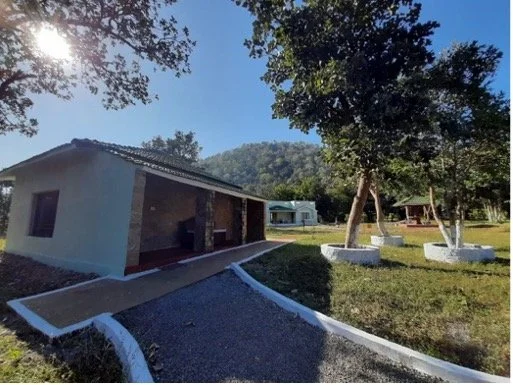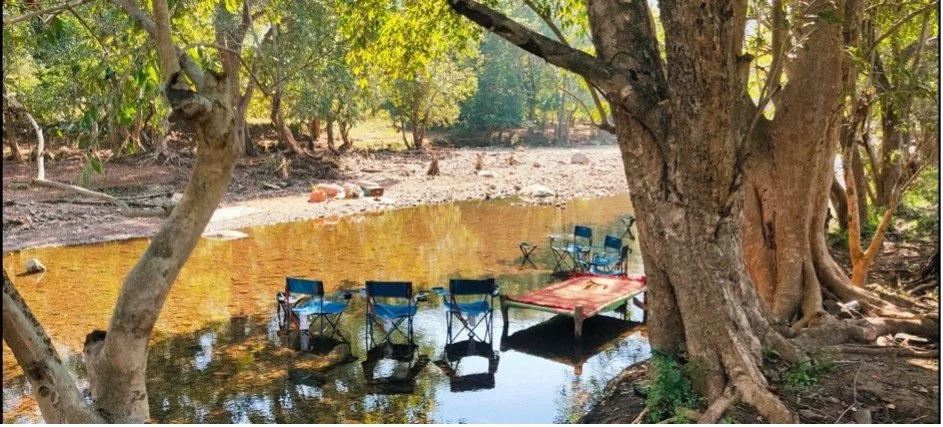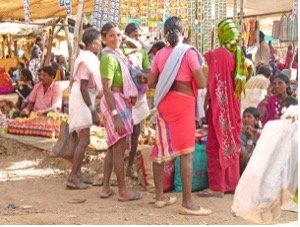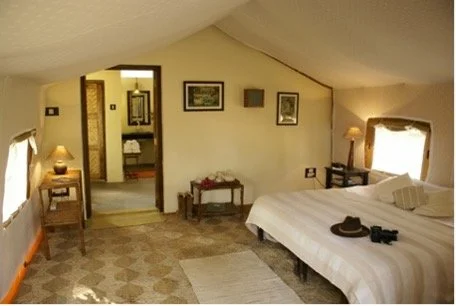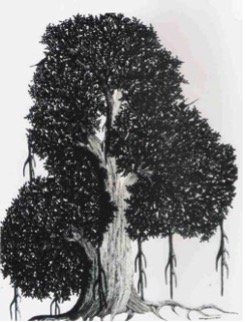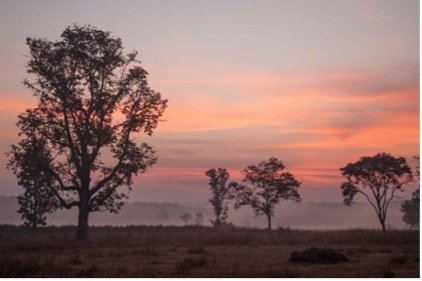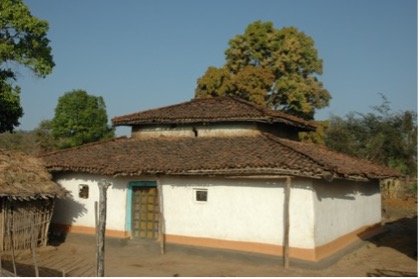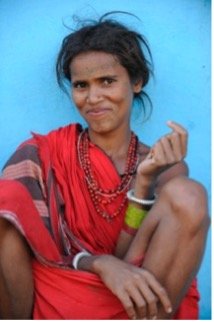Exploring Mahua In Sacred Gondowana Land with Sangeeta Khanna & Vana Safaris
EXPLORING MAHUA IN THE SACRED FORESTS OF GONDWANA LAND
WITH SANGEETA KHANNA & VANA SAFARIS
HIGHLIGHTS:
v CELEBRATING MAHUA – EXPLORING THE TRADITIONS, UNDERSTANDING THE PLANT & THE CULTURE ASSOCIATED WITH MAHUA.
v EXPLORING & TASTING TRADITIONAL RECIPES, IDEATING & CREATING NEW USES
v EXPLORING RURAL MADHYA PRADESH & CHATTISGARH WITH LOCALS
v A SAFARI TO THE KANHA NATIONAL PARK
v RELAXED, SLOW PACED WALKING EXPLORATIOSN TO VILLAGES & MARKETS
v UNDERSTANDING & WITNESSING VERNACULAR ARCHITECTURE
v SEEING THE BEATIFUL GOND ART & MEETING WITH AN ARTIST
INTRODUCTION:
The area that we fondly call Central India is almost as big as France & it encompasses all of Madhya Pradesh, a slice of Rajasthan, a part of Uttar Pradesh, Chattisgarh and Maharashtra – that is how author and botanist Pradip Krishen has demarcated it. This is a diverse area with wide variety of plants including trees, shrubs and grasslands. The trees of Central India are a set of rather handsome and beautiful trees like the haldu (adina cordifolia), sagon (Tectona grandis), saal (Shorea robusta), anjan (Hardwickia binata), semal (bombax ceiba), mahua (Madhuca longifolia var. latifolia), saaja (Terminalia tomentosa), kurlu (sterculia urens) and many more.
However Mahua is possibly the most well-known of them – for a no of reasons. The first and the most well-known reason is the liquor that is produced from the mahua flower. The second is the importance of the tree in tribal society and its role as tree where there Gods reside. So a Mahua tree escapes the axe most often and gets a very long life. There are other reasons too - “Mahua” is derived from the Sanskrit word madhu, meaning honey. It is one of the few trees well known for thousands of years. The economic importance of Mahua is mentioned in ancient Sanskrit literature such as Vedas and the Ayurveda, as well as in travelogues of foreign travelers. The Persian invaders to this land centuries ago named it ‘Darakht-i-gulchakan’ due to the deciduous nature of its flowers.
A Mahua tree can produce 300 kgs of flower in one season – individual bountiful trees are staked out and piece of cloth is tied to a branch. Once the flowering starts little kids approaching adolescence accompany their elders to the forest with a basket and after clearing the base of the tree collect the flowers carefully and bring them back. Of course, the humans only have what the animals do not – from the dangerous sloth bear & wild boars to friendly langurs and a no of other species like the civets, squirrels and bats feed on the flowers till they are a bit ‘happy’! Birds join the fest too. Even insects like the beetles and ants feast on the flowers.
There are good reasons why so many different species like them – apart from the obvious sweetness and alcohol content – the mahua is a medicinal tree providing high nutrition to the millions of the poor people. The people use it as food, they make a clear greenish oil with it and use it to cure rheumatism, and pains and aches. The oilcake left behind is used as a manure and vermicide.
Mahua being such an important tree also plays an important part in the rituals of this area. There are numerous songs that are associated with the Mahua tree, the tree is worshipped by both the Baigas and the Gonds.
Come & explore this beautiful tree-culture and enjoy this specially curated event in Central India with Sangeeta Khanna and Vana Safaris.
Sangeeta Khanna, along with local tribal folks, will demonstrate how this season is so crucial for the forest economy and culinary traditions in this area and how we can learn from their ancient wisdom that's deeply rooted in nature and the cycle of seasons. Since Mahua is a great forest resource that has been underutilised or wrongly represented, our focus is on bringing Mahua to our modern kitchens and utilise it to supplement our food while supporting the forest economy that plays an important role in making the food system a bit more fair and climate resilient at the same time. Sangeeta has planned a few tasting sessions with mahua so it will be a multisensory experience for all of you, something that will help you connect the dots about what we lack in our urban lives and how easy it is to just connect with the people at the grassroot level to bring more value to our lives.
A magical land and forest awaits us in this trip
Sketch Program
26TH APRIL’ 22 TUESDAY DAY 1 RAIPUR - BHORAMDEO
Arrive at Raipur – driven to Bhoramdeo – introduction & first outing in the fields + visit to Bhoramdeo Temple. Chattisgarhi dinner with Mahua cocktail.
The Takshak Eco Farm in Bhoramdeo is our first base - for two nights.
27TH APRIL’22 WENESDAY DAY 2 BHORAMDEO
Morning walk to the villages to see/join women mahua-pickers, followed by riverside breakfast. Day activities/discussions with Sangeeta Khanna. Post lunch village/market visit.
The riverine areas are just perfect for a cool breakfast
28TH APRIL’22 THURSDAY DAY 3 BHORAMDEO – CHILPI – KANHA
Morning walk to villages followed by breakfast & further discussions/activities focused on mahua and the culture about mahua. Post lunch – driven to Chilpi village market. Then driven to Kanha National Park. Evening a curated dinner.
The Markets or haats are the best place to meet the Baigas.
The Baiga jewellery in the market
29TH APRIL’22 FRIDAY DAY 4 KANHA
Early morning – join the mahua pickers in Kanha & visit a home to see how they work with mahua. Post lunch, a safari to the park to spot wildlife and see the flora of Kanha.
The beautiful tent - aptly named ‘Mahua’. Shergarh is one of few lodges where the names of all of the tents are after the beautiful plants and trees of Kanha.
After Takshak Eco Farm - the Shergarh will allow us a bit of luxury in the middle of Kanha Reserve Forest. These tents are comfortable with a lot of oomph and charm.
30TH APRIL’22 SATURDAY DAY 5 KANHA
After a relaxed breakfast, explore the nearby villages on foot – exploring & discussing on the vernacular architecture, meet some rural ladies & learn about their food. If we can get to meet a hand-poked tattoo maker (Godna) , we will be able to see the beautiful tattoos that are made by these ladies and have a discussion on that.
Enjoy seeing the Gond art in the lodge. Finally, enjoy a dance by the local baiga community & a curated al fresco dinner.
1ST MAY’22 SUNDAY DAY 6 KANHA – RAIPUR AIRPORT DROP
Depart after breakfast to Raipur airport.
QUOTE Max group size 10 persons
INR 59950/- per person based on twin sharing based on a minimum participation of 5 persons.
Single Supplement – INR 15800/-
INCLUDES –
v Accommodation on twin sharing basis
v One jeep safari in Kanha with a naturalist/driver
v Walks & nature explorations
v Entrances to the park
v Activities as per the itinerary
v Accompanying expert tour leader and local guides
v Taxes
DETAILS OF TRANSPORT & STAY:
v TRANSPORT AIR-CONDITIONED TEMPO TRAVELER/LOCAL CAR OR JEEP INSIDE KANHA
v ACCOMMODATION TWIN SHARING IN TAKSHAK ECO CAMP & SHERGARH TENTED CAMP
A beautiful national park that invokes the mind and the spirit.
The Tiger depends on a good mahua bloom - more mahua means more herbivores who are a bit slow with an overdose of mahua flowers and that allows the hunter a better chance to succeed in her endeavours.
The tiger is not just a physical being, it is a spirit & a metaphor. The baigas believe that the tiger will protect them in the forest & the Gonds portray them as a deity in their paintings.




